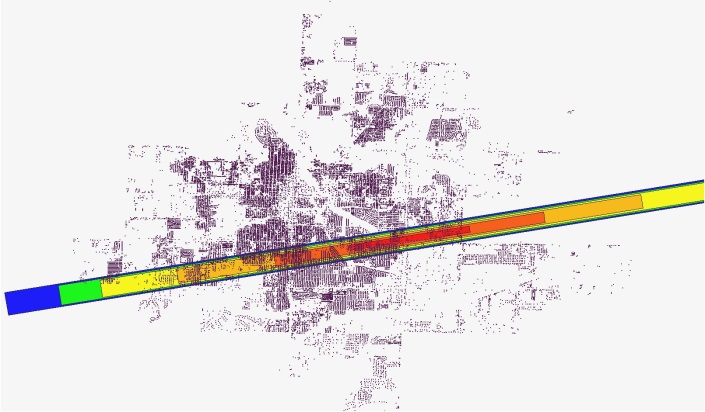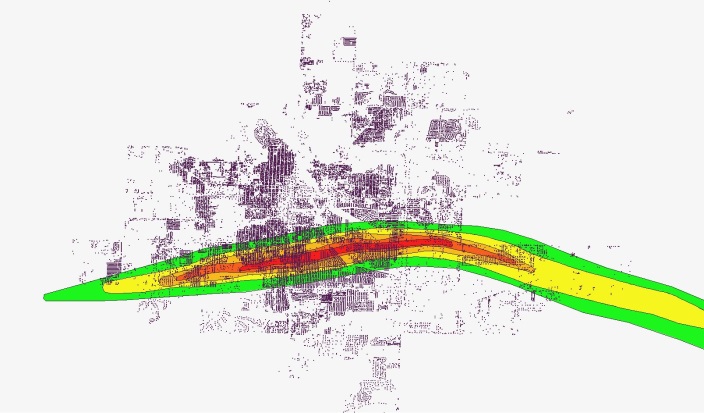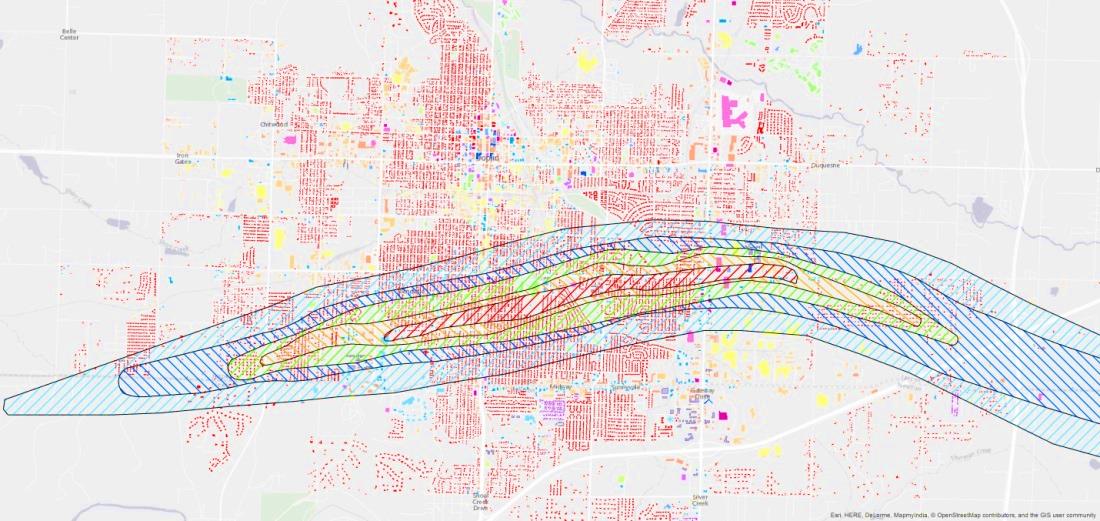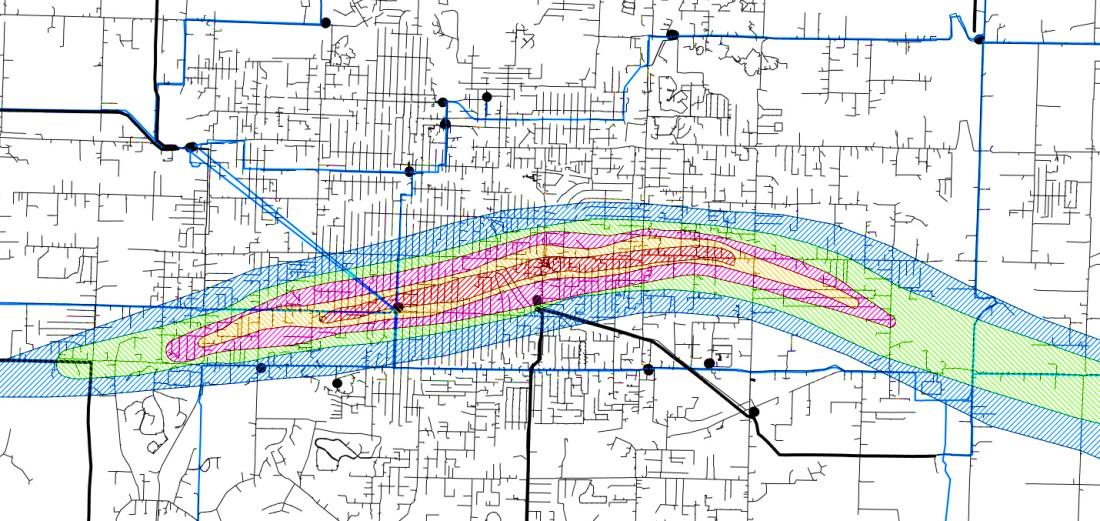The International Conference on Structural Safety and Reliability (ICOSSAR), held every four years, brings together engineers, scientists, educators, researchers and practitioners to create a better understanding and management of safety, risk and reliability of structures and systems in various fields of engineering. The latest ICOSSAR 2017, held in Vienna, Austria at the beginning of August, included a mini symposium co-organized by Ellingwood and van de Lindt entitled “Enhancing urban resilience under natural hazards” with 12 presentations over two sessions. Researchers from around the world joined a number of CoE researchers (including Guidotti, Misra, Lin and Deniz) in presenting new developments, including multi-layer heterogeneous network modeling, performance-based tsunami engineering, transportation systems and their role in community resilience assessment, railway networks, post-disaster functionality, and flood loss and recovery modeling, and financing recovery through catastrophe bonds. In addition, Paolo Gardoni and Naiyu Wang of the Center’s leadership team organized a session on “The role of climate change on hurricanes, storm surges and coastal floods,” at which several center researchers presented their work. Finally, Associate Director Paolo Gardoni gave a superb keynote lecture, entitled “Promoting societal well-being by designing sustainable and resilient infrastructure,” which highlighted much of his research team’s work within the CoE.
We are pleased to inform everyone that the Beta testing of the first version of IN-CORE is underway and will be completed in early October. Fifteen CoE post-doctoral scholars and graduate students have begun a series of exercises with IN-CORE Beta to help identify bugs and make suggestions prior to public release later this year.
Sincerely,
 |
John W. van de Lindt, Ph.D., F. ASCE Co-Director jwv@engr.colostate.edu |
 |
Bruce R. Ellingwood, Ph.D., P.E., N.A.E Co-Director Bruce.Ellingwood@colostate.edu |
In late April, the Center for Risk-Based Community Resilience Planning held its Semi-annual Meeting in Fort Collins, CO. More than ninety Center personnel attended including the Center’s Directors and Associate Directors, the Center’s leadership team, researchers, post-docs, graduate students, NIST collaborators and members from our External Assessment Panel. The Center offered an informational webinar to the greater resilience community, providing information about the end product - an open source multidisciplinary computational environment with fully integrated supporting databases (IN-CORE). Researchers discussed physics-based models of interdependent and cascading hazards and their effect on buildings, bridges, power, water/wastewater, and communication systems, the treatment of the complex interactions between physical infrastructure and the socio-economic systems in a community, quantification and measurement of factors that make a community resilient to hazards, and a risk-informed basis for decision-making.
The WEBINAR “Community Resilience: Modeling, Field Studies and Implementation” was recorded and may be viewed on YouTube: https://youtu.be/eyjzCDxcdSA.
by Paolo Gardoni
The National Center for Supercomputing Applications (NCSA) at the University of Illinois at Urbana-Champaign (UIUC) announces the retirement of Mr. Danny Powell, Executive Director of NCSA, as of December 2016. As part of the NIST-funded Center of Excellence for Risk-Based Community Resilience Planning, Danny has been serving as the Data/Framework Team Lead as well as leading the efforts in Thrust 2. In consultation with the Center’s co-directors, Prof. John van de Lindt and Prof. Bruce Ellingwood, the UIUC team led by Prof. Paolo Gardoni is proposing that the position left vacant by Danny be filled by Dr. Jong Sung Lee. Jong has been intimately involved in the development of IN-CORE and Thrust 2 since the beginning of the Center.
Dr. Jong S. Lee is a Senior Research Scientist at the National Center for Supercomputing Applications (NCSA) at the University of Illinois at Urbana-Champaign (UIUC) where he co-leads the Innovative Software and Data Analysis Group (ISDA). Jong also holds a Lecturer position in the Department of Urban & Regional Planning at UIUC. He received a M.S. of Urban Planning and a Ph.D. in Regional Planning from UIUC in 1999 and 2005, respectively. His research interests focus on designing, developing and operating end-to-end cyber-environments that support various research and education communities. He is particularly interested in the role of geographic information sciences and systems in cyber-environments of various scientific domains.
by John W. van de Lindt, Hussam Mahmoud, Navid Attary and Stephanie Pilkington
Additional Task Team Members: Steve Smith, Sammy Zahran, Harvey Cutler, Martin Shields, Elaina J. Sutley, Sara Hamideh, Walter Peacock, Nathanael Rosenheim, Yu Xiao, Lori Peek, Maria Koliou, Andrew Graettinger, Suren Chen, Mehrdad Memari, Stephanie Pilkington, Hassan Masoomi, Jennifer Tobin-Gurley, Todd Clapp, Derya Deniz, Shane Crawford, Christopher Navarro, Jong Sung Lee and Yong Wook Kim.
The objective of the hindcasting task is to systematically validate the accuracy of IN-CORE modeling approaches of individual physical sectors, coupled sectors, social and economic sectors, and full events. The first hindcasting for the Center of Excellence has been focused on the Joplin tornado. On May 22nd 2011, an EF-5 tornado (rated based on the Enhanced Fujita tornado intensity scale) cut more than a 6-mile path of destruction through the city of Joplin, MO. With wind speeds of more than 200 mph, the ¾-mile-wide tornado caused 161 fatalities, approximately 1,371 injuries and more than $2.8 billion in losses, making it the deadliest and costliest single tornado in the country since 1947. It should be noted that Doppler radar, and thus early warning for tornadoes, did not exist in 1947 as it did in 2011. The Center of Excellence (CoE) team visited the City of Joplin and gathered a large amount of existing data from before and after the tornado to be able to hindcast (and for comparison) the event and has conducted (or is conducting) analysis with the following tornado types as part of this sub-task.
- Tornado Type 1: A generic EF5 tornado will be applied with mean width and length
- Tornado Type 2: A generic EF5 tornado with random width and length.
- Tornado Type 3: The actual tornado centerline with mean width and length form NOAA data set.
- Tornado Type 4: The actual tornado centerline and EF regions as determined from NIST NCSTAR 3 (2014). This type of tornado provides the majority of the hindcasting information for models and methods being developed within the CoE.
Each of these tornado types will be applied to a series of analyses by a number of CoE researchers, which includes the 11 analyses types outlined below. Each will include comparison to existing data collected either immediately following the event or during Joplin’s path to recovery, by the Task team and others in the community.
Analysis 1. Building damage analysis: Building fragilities will be combined with the tornado wind speeds to provide a probability of each building in Joplin being in one of four damage states, namely Slight, Moderate, Extensive and Complete.Analysis 2. Electrical Power Network (EPN) damage and loss of functionality: Damage to the EPN and loss of functionality using a modified cellular automata model.
Analysis 3. Coupled building and EPN functionality: A combination of Analyses 1 and 2 for building functionality.
Analysis 4. Business disruption: An analysis showing the loss of businesses.
Analysis 5. Computable generalized equilibrium of the economy with Quarterly Census of Employment and Wages (QCW): A detailed assessment of the economic impact of the tornado.
Analysis 6. Recovery of functionality for buildings: This is an isolated building repair analysis of Joplin, assuming permits and crews are available.
Analysis 7. Economic recovery including domestic supply, household income and employment: A Computable General Equilibrium (CGE) analysis to estimate the economic recovery without any integration of the physical infrastructure.
Analysis 8. Recovery of economy with annual updating of physical infrastructure recovery: Same as Analysis 7 but with annual updates to the building functionality.
Analysis 9. Population dislocation using small area model: Estimate of the number of household dislocated by the tornado.
Analysis 10. Housing recovery model comparison to Joplin recovery data (parcel method): Prediction of housing recovery using improvement value as a proxy.
Analysis 11. Housing recovery model compared to Joplin recovery data (building cluster approach): Apply a discrete state continuous Markov Chain approach to generate restoration curves, ultimately predicting the recovery time.
The majority of these analyses are underway with several waiting on data or information to proceed.
Building Damage Analysis
As an example of some of the completed and ongoing analysis, the engineering team at Colorado State University completed a building damage analysis in collaboration with IN-CORE programmers at the National Center for Supercomputing Applications (NCSA). Pre-disaster details of all of the buildings in the city of Joplin were gathered and imported into IN-CORE and the four tornado scenarios mentioned previously, were simulated in the software. Figure 1, shows two of the scenarios as an example.
 |
 |
Figure 1. Buildings in the city of Joplin, modeled in IN-CORE for two tornado scenarios: a generic EF5 tornado (left) and actual tornado centerline with EF regions (right) (Attary et al., 2017a)
In order to estimate the damage caused by the scenario tornadoes, the engineering team at CSU categorized the buildings in the community into 19 archetypes and developed tornado fragilities for each type (Memari et al., 2017). Each one of the 19 fragilities was assigned to each building in the city of Joplin. Figure 2, shows the different building types (different colors in the figure), assigned to more than the 40,000 buildings throughout the city. Using the wind speed for each building during the various tornado scenarios, combined with the fragilities, the probability of damage to each building was estimated for different damage states, using IN-CORE (Attary et al., 2017a). The results of this analysis were used as inputs for other analyses (analyses 3 – 11) which are currently under development by Econ/Social team.
 |
Figure 2. 19 architype buildings in the city of Joplin and the actual tornado path and EF zones
Electrical Power Network Damage and Power Loss
Detailed pre-disaster data, including substations, transmission lines, distribution lines, etc. of the Electrical Power Network (EPN) for the city of Joplin was graciously provided to the engineering team at CSU by Empire Electric Co. Figure 3, shows the details of the EPN overlaid the actual tornado path.
 |
Figure 3. Details of Electrical Power Network of the city of Joplin (Provided by Empire Electric Co.)
In order to estimate the electric power loss after the disaster, it is critical to know the service areas of the substations, connectivity of the electrical poles and the path that delivers electric power to each customer. A weighted cellular automata technique was used by the engineering team at CSU to estimate these parameters and the results, combined with fragilities of electrical poles and towers to estimate the probability of power loss for all of the buildings in Joplin (Attary et al., 2017b). The results were compared with actual power loss reports after the event and although many power loss reports were located outside of tornado path, the results were promising (Attary et al., 2017b). The probabilistic results of electric power loss were then combined with the results from the building damage assessment discussed previously, to provide coupled building and EPN functionality (Attary et al., 2017b), immediately following the tornado. Detailed results of the analyses will be presented during the CoE semi-annual meeting at Gaithersburg this November.
Acknowledgment
The team would like to thank Mike Fobair and Tina Gaines from Empire District Electric Co. for their help in providing data of the electrical power network. The team would also like to thank Dr. Steve Smith from the Department of Geography at Missouri Southern State University for helping facilitate many logistical issues during the field study and for providing various technical insights, particularly with regard to GIS.
References can be found on the Center of Excellence Publication Listing web site.
by Maria Dillard and Ken Harrison, NIST
Summer 2017
This summer, the NIST Community Resilience Program was joined by three undergraduate research fellows. NIST research in the area of resilience focuses on providing guidance and tools to increase the ability of communities to plan for hazards. The CoE and NIST 2016 visit to Lumberton, North Carolina following the devastating flooding from Hurricane Matthew highlights the importance of resilience planning. The student research projects touch on aspects that could benefit communities such as Lumberton. The students are conducting work that supports the resilience and disaster failure research projects of Judy Mitrani-Reiser, Ken Harrison, and Maria Dillard.
Three students are participating in the NIST SURF Program that encourages undergraduate students to pursue careers in STEM through a unique research experience in support of the NIST mission. Since 1993, SURF students from across the country have had the opportunity to gain valuable, hands-on experience, working with cutting edge technology in one of the world's leading research organizations and home to three Nobel Prize winners. Over the course of 11 weeks, SURF students contribute to the ongoing research of one of the seven NIST laboratories. The SURF Program is administered at the Gaithersburg, MD and Boulder, CO locations.
Nathan Idrogo, from Laredo, Texas, just completed his BS in Civil Engineering at Texas Tech University and is looking forward to pursuing an MS in Civil Engineering at Purdue University this fall. Nathan is reviewing protocols from past studies/investigations of the NIST Disaster and Failure Studies Program in order to identify and test tools for reconnaissance. He is also reviewing representative sampling methodologies for evaluating building performance during regional disaster investigations. His research will contribute to identifying the most scientific and effective sampling methodologies that exist. Should these current methodologies be judged as inadequate for NIST regional disaster investigations, a standardized sampling methodology will be developed to support future disaster investigations.
Massiel González Perez was born in the Dominican Republic. She moved to Puerto Rico five years ago and attended Caribbean University where she recently completed a BS in Civil Engineering. Her plans for the near future is to attend grad school for a MS degree in Environmental Engineering. Massiel is conducting a systematic literature review on household recovery using methods comparable to those used by CoE researchers, Hamideh and Sutley, in their work on housing recovery. The literature review will contribute to the development of a model of household recovery through identification of definitions, measurement, and causal factors. The literature review is part of a NIST and CoE collaboration focused on the concept of recovery.
Joshua Fernandez was born and raised in Maryland. He joins us from the University of Maryland, Baltimore County where he is a junior studying Mechanical Engineering. Joshua is building a simplified spreadsheet-based simulation model aimed at helping a community improve its resilience. The sets of decisions and modeling are based off of the Lumberton flooding experience. The model will help to inform the development of a mathematical programming-based decision support tool in development at NIST.
In June, the team will also be joined by another student through NIST’s Summer High School Intern Program (SHIP). Emily Shin will be working on a disaster failure studies data management and archival project.
Collectively, the students’ research promises to help communities such as Lumberton to avoid hazard events from becoming disasters.
Recent meetings of interest
- 3rd Global Summit for Research Institutes for Disaster Risk Reduction (GSRIDRR) and the 1st GADRI General Assembly being held at Kyoto University, Uji Campus, Kyoto Japan- March 19-21, 2017.
- ASCE/ SEI Structures Congress 2017, Denver, CO April 6-8, 2017
- 2017 Annual Natural Hazards Research and Application Workshop - July 9-12, 2017
- 12th International Conference on Structural Safety and Reliability (ICOSSAR 2017), Vienna, Austria, August 6 - 10, 2017
- Resilience Week 2017, Wilmington, DE, September 18 - 22, 2017
Upcoming Meetings, Conferences, and Workshops of Interest:
- 2nd International Workshop on Modelling of Physical, Economic and Social Systems, 14-16 December 2017, Brussels, Belgium. For more information click here: Modeling Workshop.
Padgett awarded ASCE's Huber Prize
Jamie E. Padgett, Associate Professor of Civil and Environmental engineering at Rice University, has been awarded the prestigious 2017 Walter L. Huber Civil Engineering Research Prize from the American Society of Civil Engineers (ASCE). ASCE awards the Huber Prize to members with notable achievements in research related to civil engineering. It is considered the highest level mid-career research prize in the field, and is awarded annually to only a few researchers across all civil engineering disciplines. Read more on Jamie’s accomplishment here: https://engineering.rice.edu/padgett_huber_prize.
Ellingwood receives ASCE’s Ang Award
Professor Bruce R. Ellingwood, Center Co-Director, is to be awarded the 2017 Alfredo Ang Award on Risk Analysis and Management of Civil Infrastructure “for significant advancement of and outstanding contributions in the field of probabilistic risk analysis and management of civil infrastructure, notably in performance-based design, structural safety, reliability, and resilience in relation to abnormal loads and progressive collapse.” The award will be given at the 2018 SEI/ASCE Structures Congress in Dallas-Fort Worth.
SUNY Board Names Havidán Rodríguez 20th President of the University at Albany
Rodríguez, comes to UAlbany with 25 years of experience as a leader in higher education. He was the founding provost and executive vice president for academic affairs at The University of Texas Rio Grande Valley (UTRGV) and a respected scholar who studies the socio-economic impacts of disasters and the economic well-being of minority populations in the United States and Puerto Rico. He is also a strong advocate for involving undergraduates in research. To read more about this outstanding news: http://www.albany.edu/news/79681.php.
Congratulations Havidán!
In January of 2016, NIST launched a new BLOG called Taking Measure, Just a Standard Blog. The posts, about one a week, are written by NIST’s researchers and staff and provide a behind-the-scenes look at a broad range of science and technology research. Catch up on the recent articles and sign up for blog email alerts here: https://www.nist.gov/blogs/taking-measure
